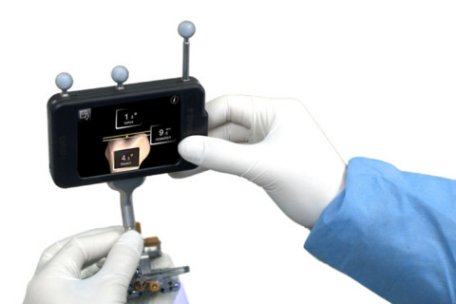
Last month, I wrote an article about an experiment involving spiders and an iPod touch. The results of the experiment were interesting, but I also thought it was really cool that an iPod was integral to the experiment’s design. Well, I just learned about something that I think is is even cooler. It turns out that an iPod touch is being used to assist in knee-replacement surgeries!
The system is called “Dash,” and it is made by a company called Brainlab. It consists of several accessories, such as probes, that attach to an iPod touch. Once everything is sterilized, the surgeon can use the probes to make measurements on the patient while the surgery is in progress. The iPod can then do some calculations on those measurements and show an image that will help the doctor install the artificial knee as accurately as possible. It can also use its WiFi capabilities to send those results to any other device, such as an iPad, if the surgeon wants a larger, more detailed image.
Why would a surgeon use a device like this? Well, in order for the replacement knee to function well, it must be aligned properly. In conventional knee replacement surgeries, the surgeon inserts a metal rod into the femur (the bone above the knee) to help with this alignment. Unfortunately, that process can increase the risk of certain side effects, such as fat embolisms. When using this iPod-based device, there is no need for an alignment rod. In addition, a surgeon who has been using it for more than a year says that the device provides better alignment than the conventional method. This leads to a larger range of motion for the artificial joint. Also, patients experience less pain and swelling after surgery.
The surgeon also claims that the lifetime of an artificial knee will be longer longer if it is installed using this device, but I am skeptical of that claim. The average lifetime for an artificial knee is about 10-15 years, so I don’t think anyone has been using the device long enough to determine how it will affect the lifetime of the replaced knee. However, a reduction in side effects and an increased range of motion are reasons enough to use the device.
Now please understand that this isn’t the only electronic device available for knee replacement surgeries. There are other such devices, but they are bulky. In addition, the image is displayed on a fixed monitor. As a result, the surgeon often has to turn his or her head to look at the image. In this system, hand-held devices allow the surgeon (or an assistant) to hold the screen wherever it is most convenient.
One other benefit of this system is its cost. The iPod-based system is less expensive than the other electronic systems that are available for these kinds of surgeries. This isn’t surprising, because the iPod is mass produced. As a result, it is a lot cheaper than an electronic system in a specialty product that is built solely for medical professionals.
In my previous article about the spider experiment, I said that a good experimentalist uses what is readily available rather than spending a lot of time trying to “re-invent the wheel.” The same can be said for a good engineer. I think that as time goes on, you will see more scientific and medical devices that take advantage of highly-versatile consumer products like the iPod and the iPad.

It’s not just devices–I would argue that Google Earth has the potential to revolutionize geological research as well, by providing an economical, user-friendly way to measure, tag and analyze geological features on a scale undreamed of even ten years ago.
Excellent point, J.S.!
Dr. Wile, I don’t know why this just occurred to me, but do you have any proof that you were ever an atheist? I’m afraid some apologists have fudged this claim, so I think it is reasonable to ask.
– written on an iPhone
No, Mia, I do not. That was back in the late 1970s. I was in an atheist discussion group back then, and I probably even wrote some essays about why I was an atheist. However, I’m not sure I have anything from my life 30 years ago, much less 40 years ago.